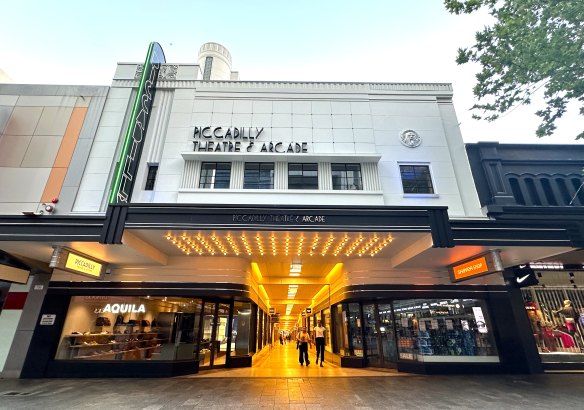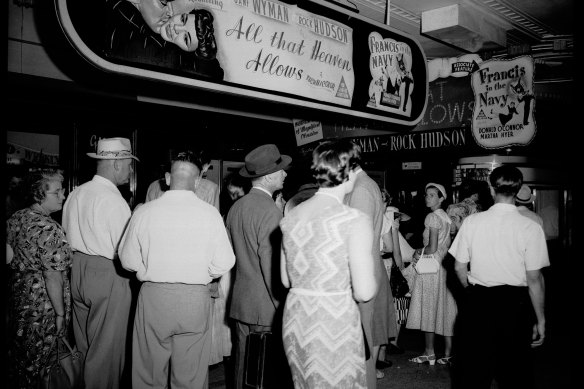By Mark Naglazas
When it was announced that the moribund Piccadilly Theatre would be reborn as a live entertainment venue it was as rapturously received as a classic movie in Hollywood’s Golden Age.
Perth’s central city Art Deco icon had screened its last film five years earlier, with the operator heavily in debt and its “flaking” asbestos ceiling collapsing on the heads of startled customers (The West Australian called it “a horror movie in the CBD”).

Piccadilly Theatre: the arcade is filling up, but the theatre is awaiting an operator.Credit: Mark Naglazas
So when veteran music promoter Brad Mellen approached the City of Perth with the idea of repurposing the Piccadilly as a live performance space it was enthusiastically embraced by the local arts scene and councillors anxious to reinvigorate the blighted Hay Street Mall.
Seven years and millions of dollars later – $665,000 of it from ratepayers via a “heritage adaptive re-use grant” – the new concert venue is still a dream.
At ground level the spruced-up Piccadilly Arcade between Hay and Murray streets is now filling with retailers and shoppers.
But the owner of both spaces, South East Asian investment group Winston Holdings, has yet to sign a contract for an operator to run its upstairs theatre after Mellen pulled out of the deal in 2021.
The stalled project provides insight into what’s happening – or, more accurately, what’s not happening – in the rest of the city, whose many heritage buildings are boarded up because the owners are not sufficiently motivated to develop their properties.
If a building that has a genuine purpose to be revived and has owner willing to invest money (up to a point) then what hope is there for the rest of the heritage-listed buildings on and around the Hay Street Mall?
The Piccadilly Theatre was one of a number of cinemas built between the wars, along with the Ambassadors, Plaza, Metro and the Capitol, that made Hay Street the city’s entertainment mecca.
The glory days were long gone when Mellen approached the City of Perth with the idea of converting the space, which had fallen into such disrepair it even hosted squatters, into a venue for live entertainment – and a $1.7 million sponsorship request.
Councillors were initially enthusiastic.
But a complaint about the lavish sponsorship from commercial rival Adrian Fini, who at the time was transforming the heritage-listed Rechabite in Northbridge into a similar performance space, prompted the City to withdraw its support.
The project was saved by the city’s offer of an $80,000 a year rates reduction. However, it was not enough to prevent Mellen and the owner parting company, despite the promoter sinking a reported $1 million of his own money into the renovation, which remains unfinished with no toilets and no seating.
Currently, Winston Holdings’ leasing agent CBRE is seeking an operator for the Piccadilly. This masthead approached the owners, their Perth representative and CBRE for comment, but all declined. Mellen also did not respond.
WAtoday was able to get a clearer picture through discussion with various insiders, who all chose to remain anonymous for fear of affecting their relationships in their industry.
“The Piccadilly was derailed by COVID-19,” explained one.
“Costs were mounting on the project, but that’s what happens when you are renovating an old building. But when COVID-19 struck the owner was not willing to sink the millions necessary because it was unclear how long the lockdown would last.”
“It is very difficult to make a commercial case for the millions needed to bring these heritage buildings up to spec because this part of the city is dead.”
While the pandemic has passed, building costs in Western Australia remain sky-high, so whoever wants the lease will have to persuade the owner to spend the money or spend it themselves.
“Trying to land on a business model to make this work will be very difficult,” said my contact.
Another insider said making the Piccadilly work would be a challenge because of its size. Its projected capacity of 1084 is smaller than nearby rivals The Regal in Subiaco and The Astor in Mount Lawley, neither of which face the rent pressures the foreign-owned Piccadilly would.
“It will need significant government subsidy to make it work,” said my contact. “A private operation like the Piccadilly is competing against those which are heavily subsidised by the government.
“It doesn’t matter whether the buildings are owned by Asian investors or they’re homegrown. It is very difficult to make a commercial case for the millions needed to bring these heritage buildings up to spec because this part of the city is dead,” he tells me.

The Piccadilly Theatre in 1956 was one of several cinemas that the made Hay Street the entertainment mecca of Perth.Credit: State Library of Western Australia
“Who’s going to be brave enough to be the first one in? Without something like the Piccadilly you have no people; without the people you have no Piccadilly.”
Sarah Booth of Spacemarket, a company dedicated to “pairing disused spaces with useful people”, worries that the cost of revitalising heritage buildings is so high nobody is prepared to pay it.
“It’s almost a stalemate,” said Booth. “There are all these buildings in the CBD sitting vacant because the owners don’t see it as good business sense to use them.
“Should we demand owners spend millions to make them perfect, or do we allow them to have a minimal make-over so they can be used? This is the future of our city. What do we need to do to make our city into a vibrant place that people want to live in and tourists want to visit?”
Start the day with a summary of the day’s most important and interesting stories, analysis and insights. Sign up for our Morning Edition newsletter.